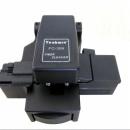How to Use a Fusion Fibre Splicer

Fibre Optic Splicing methods are significant to any LAN & Networking or Telecommunications firm. It is the technique of linking two optical fibres by melting at their edges. Termination is another method of joining two fibre optics, which is more common in use. When using a fibre splicer to join optic fibres, it reduces light loss and rear reflection compared to termination.
When you need to join two dissimilar cables together or if the cable length is too long, fibre splicing is beneficial in comparison to termination. Mainly there are two techniques used for fibre splicing; mechanical splicing and fusion splicing or Fusionadora. Hence, it is necessary to understand which of these methods fit you well according to your performance and financial goals.
Two Types of Fibre Optic Slicing:
• Fusion Splicing
In fusion splicing of two optical fibres, a machine is used to exactly align both fibre ends and then melt this glass ends together with the use of an electric arc or any other type of heat. The joint thus formed or fusion splice joins two or more glass fibres together, which lets optical light signals can transmit from first fibre to the second with minimal loss light transmission.
• Mechanical Splicing
In mechanical splicing, some alignment means is used to keep the tow optical fibres in the exact alignment with each other. This lets light transmission through both fibres, but with a higher loss light diffusion compared to fusion splicing.
Steps in Fusion splicing
• Get the fibres prepared for merging by removing the protective coatings on it such as jackets, strength members or tubes in the cleanest way possible.
• You need to cleave the fibre end in a perpendicular position which gives a smooth end to the fibre. There are very good cleaving devices available in the market to cut the fibres consistently in the same angle which results in a mirror-smooth edge.
• Next comes fusing which involves alignment and melting. You can use a manual or automatic alignment device to keep fibres in precise position and the accuracy of it depends on the quality of device used. Once aligned, you can melt the ends of fibres using an electric arc, which joins the fibres together forever.
• Finally it is essential to protect this splicing from pulling forces and extreme twisting, with the help of silicone gel, mechanical crimp protectors or heat shrink tubing.
Techwin Industry Co. is a reputed company with many years of experience in selling fusion splicing devices like OTDR, Optical Fibre Identifier, Fibre light source and much more. You can check their portal www.fsm-otdr.com, for a detailed view of their services and various products.
When you need to join two dissimilar cables together or if the cable length is too long, fibre splicing is beneficial in comparison to termination. Mainly there are two techniques used for fibre splicing; mechanical splicing and fusion splicing or Fusionadora. Hence, it is necessary to understand which of these methods fit you well according to your performance and financial goals.
Two Types of Fibre Optic Slicing:
• Fusion Splicing
In fusion splicing of two optical fibres, a machine is used to exactly align both fibre ends and then melt this glass ends together with the use of an electric arc or any other type of heat. The joint thus formed or fusion splice joins two or more glass fibres together, which lets optical light signals can transmit from first fibre to the second with minimal loss light transmission.
• Mechanical Splicing
In mechanical splicing, some alignment means is used to keep the tow optical fibres in the exact alignment with each other. This lets light transmission through both fibres, but with a higher loss light diffusion compared to fusion splicing.
Steps in Fusion splicing
• Get the fibres prepared for merging by removing the protective coatings on it such as jackets, strength members or tubes in the cleanest way possible.
• You need to cleave the fibre end in a perpendicular position which gives a smooth end to the fibre. There are very good cleaving devices available in the market to cut the fibres consistently in the same angle which results in a mirror-smooth edge.
• Next comes fusing which involves alignment and melting. You can use a manual or automatic alignment device to keep fibres in precise position and the accuracy of it depends on the quality of device used. Once aligned, you can melt the ends of fibres using an electric arc, which joins the fibres together forever.
• Finally it is essential to protect this splicing from pulling forces and extreme twisting, with the help of silicone gel, mechanical crimp protectors or heat shrink tubing.
Techwin Industry Co. is a reputed company with many years of experience in selling fusion splicing devices like OTDR, Optical Fibre Identifier, Fibre light source and much more. You can check their portal www.fsm-otdr.com, for a detailed view of their services and various products.
Advertise on APSense
This advertising space is available.
Post Your Ad Here
Post Your Ad Here
Comments